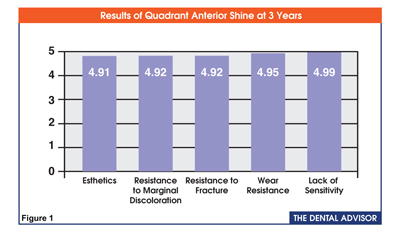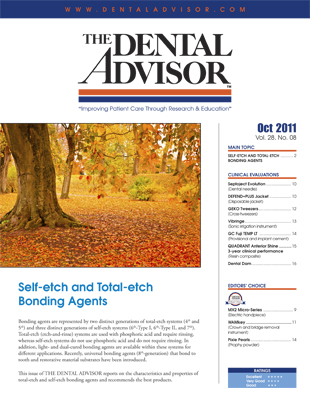Clinical Evaluations
Quadrant Anterior Shine (3-yr)
Description
Quadrant Anterior Shine is a light-cured, radiopaque, Bis-GMA, micro-hybrid composite. It is filled 63% by volume and 74% by weight. The composite is indicated for Class III, IV, and V restorations and is available in 15 shades: A1, A2, A3, A3.5, A4, B2, B3, C2, C4, D3, OA2, OA3.5, Dark, Incisal, and Bleach. Fluorescent pigments increase the vitality of the restored teeth. The refractive index of the barium glass helps the restoration to blend with the tooth. Quadrant Anterior Shine is available in 0.25 g unit-dose capsules and 4 g syringes. The starter kit contains five syringes or 50 capsules of composite (shades A2, A3, A3.5, AO3.5, and Incisal), a 2.5 mL syringe of Quadrant Total Etch (20% phosphoric acid), a 4 mL bottle of Quadrant Uni-1-Bond, and accessories.
Clinical Observations
Over 500 restorations have been placed using Quadrant Anterior Shine in the past four years. Quadrant Anterior Shine was used mainly in areas where esthetics was a primary concern. At placement, consultants found the composite material was easy to place, handled well and sculpted nicely. The surface finish was smooth and the shades blended well with the surrounding tooth structure. 141 restorations were observed in 72 patients during recall visits at three years.
Esthetics
At three years in the mouth, Quadrant Anterior Shine restorations exhibited superb esthetics both in luster and shade stability. Over 98% percent of the restorations were rated as excellent at recall visits.
Resistance to Marginal Discoloration
A variety of 5th– and 6th-generation bonding agents were used to bond Quadrant Anterior Shine restorations. The majority of the restorations were resistant to staining (Figure 1).

Fracture Resistance
Ninety-eight percent of Quadrant Anterior Shine restorations were intact at three years in the mouth (Figure 1). Four restorations fractured or debonded and were subsequently replaced.
Wear Resistance
The majority of the restorations observed at three years retained their initial luster (Figure 1). Only two Class III restorations exhibited slight dulling. They were easily polished back to their original finish.
Summary
Quadrant Anterior Shine received a 98% rating for clinical performance at three years.

